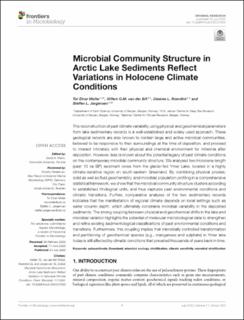Microbial community structure in Arctic lake sediments reflect variations in Holocene climate conditions
Journal article, Peer reviewed
Published version

Åpne
Permanent lenke
https://hdl.handle.net/11250/2766475Utgivelsesdato
2020Metadata
Vis full innførselSamlinger
- Department of Earth Science [1034]
- Registrations from Cristin [9489]
Sammendrag
The reconstruction of past climate variability using physical and geochemical parameters from lake sedimentary records is a well-established and widely used approach. These geological records are also known to contain large and active microbial communities, believed to be responsive to their surroundings at the time of deposition, and proceed to interact intimately with their physical and chemical environment for millennia after deposition. However, less is known about the potential legacy of past climate conditions on the contemporary microbial community structure. We analysed two Holocene-length (past 10 ka BP) sediment cores from the glacier-fed Ymer Lake, located in a highly climate-sensitive region on south-eastern Greenland. By combining physical proxies, solid as well as fluid geochemistry, and microbial population profiling in a comprehensive statistical framework, we show that the microbial community structure clusters according to established lithological units, and thus captures past environmental conditions and climatic transitions. Further, comparative analyses of the two sedimentary records indicates that the manifestation of regional climate depends on local settings such as water column depth, which ultimately constrains microbial variability in the deposited sediments. The strong coupling between physical and geochemical shifts in the lake and microbial variation highlights the potential of molecular microbiological data to strengthen and refine existing sedimentological classifications of past environmental conditions and transitions. Furthermore, this coupling implies that microbially controlled transformation and partitioning of geochemical species (e.g., manganese and sulphate) in Ymer lake today is still affected by climatic conditions that prevailed thousands of years back in time.
